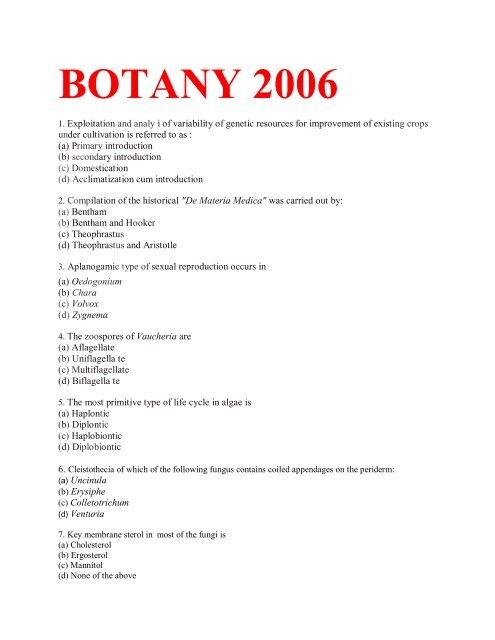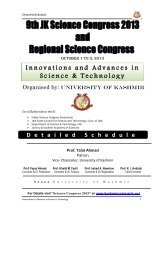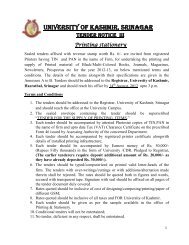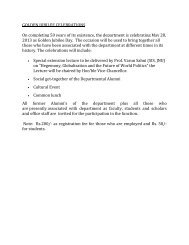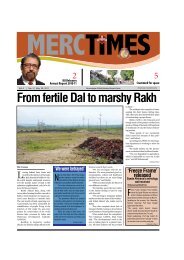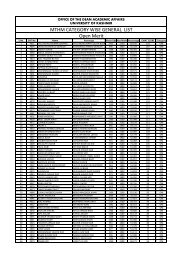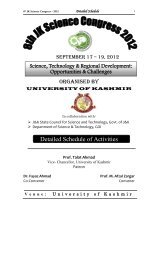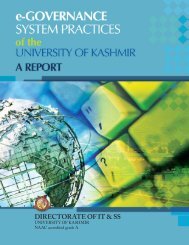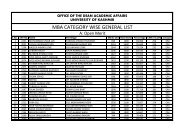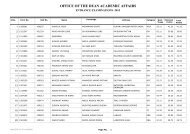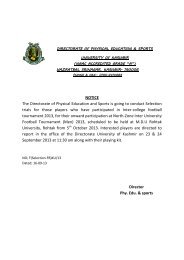BOTANY 2006
BOTANY 2006
BOTANY 2006
- No tags were found...
You also want an ePaper? Increase the reach of your titles
YUMPU automatically turns print PDFs into web optimized ePapers that Google loves.
<strong>BOTANY</strong> <strong>2006</strong><br />
1. Exploitation and analy i of variability of genetic resources for improvement of existing crops<br />
under cultivation is referred to as :<br />
(a) Primary introduction<br />
(b) secondary introduction<br />
(c) Domestication<br />
(d) Acclimatization cum introduction<br />
2. Compilation of the historical "De Materia Medica" was carried out by:<br />
(a) Bentham<br />
(b) Bentham and Hooker<br />
(c) Theophrastus<br />
(d) Theophrastus and Aristotle<br />
3. Aplanogamic type of sexual reproduction occurs in<br />
1.<br />
(a) Oedogonium<br />
(b) Chara<br />
(c) Volvox<br />
(d) Zygnema<br />
4. The zoospores of Vaucheria are<br />
(a) Aflagellate<br />
(b) Uniflagella te<br />
(c) Multiflagellate<br />
(d) Biflagella te<br />
5. The most primitive type of life cycle in algae is<br />
(a) Haplontic<br />
(b) Diplontic<br />
(c) Haplobiontic<br />
(d) Diplobiontic<br />
6. Cleistothecia of which of the following fungus contains coiled appendages on the periderm:<br />
(a) Uncinula<br />
(b) Erysiphe<br />
(c) Colletotrichum<br />
(d) Venturia<br />
7. Key membrane sterol in' most of the fungi is<br />
(a) Cholesterol<br />
(b) Ergosterol<br />
(c) Mannitol<br />
(d) None of the above
8. Nutrition in slime fungi is<br />
(a) Absorptive<br />
(b) Phagotrophic<br />
(c) Necrotrophic<br />
(d) Autotrophic<br />
9. Which among the following is used as a biocontrol agent?<br />
(a) Trichoderma viridae<br />
(b) Pythium debaryanum<br />
(c) Phytophthora infestans<br />
(d) Erysiphe polygoni<br />
10. Phialidic type of conidia are found in<br />
(a) Asperigillus<br />
(b) Albugo<br />
(c) Phytophthora<br />
(d) Pythium<br />
11. When the tissue close to vein turns yellow and the remaining surface o~ stays green; the<br />
condition is known as<br />
(a) Vein bending<br />
(b) Vein clearing<br />
(c) Variegation<br />
(d) Vennation<br />
12. When archegonia are borne at the apex of main axis or its branches, the condition is known a<br />
(a) Acrocarpous<br />
(b) Pleurocarpou<br />
(c) Stigmatocarpous<br />
(d) Cleistocarpous<br />
13. Conducting tissue in mosses is made up of: .j<br />
(a) Xylem<br />
(b) Collenchyma<br />
(c) Phloem<br />
(d) Parenchyma<br />
14. Green plastids are present in the cells of young antheridium of:<br />
(a) Riccia<br />
(b) Funaria<br />
(c) Pellia<br />
(d) Anthoceros<br />
15. A group of fused sporangia with distinct partition walls is known as<br />
(a) Sorus<br />
(b) Synangium
(c) Both (a) and (b)<br />
(d) None of the above<br />
16. Which of the following can induce apogamy in fern gametophytes?<br />
(a) Low concentration of sucrose'<br />
(b) Medium concentration of sucrose<br />
(c) High concentration of sucrose<br />
(d) All of the above<br />
17. Which of the following IS richly found m functional megasporophyte of<br />
Selaginella ?<br />
(a) Vacuoles<br />
(b) Starch<br />
(c) Cytoplasm<br />
(d) Cytoplasmic RNA \<br />
18. Which of the following genera lacks a female cone?<br />
(a) Cycas<br />
(b) Cedrus<br />
(c) Ephedra<br />
(d) None of the above<br />
19. The form genus Caytonia was first discovered by<br />
(a) H. H. Thomas<br />
(b) T. M. Harris<br />
(c) K. R. Sporne<br />
(d) B. Sahni<br />
20. In which. geological period flowering plants first appeared?<br />
(a) Ordovician<br />
(b) Cambrian<br />
(c) Devonian<br />
(d) Cretaceous<br />
21. Girdling leaf-traces are the characteristic feature of the stem of:<br />
(a) Ephedra<br />
(b) Cycas<br />
(c) Cedrus<br />
(d) Pinus<br />
22. Which of the following living pteriodophytic order shows more resemblances with Rhyniaceae?<br />
(a) Psilotales<br />
(b) Lycopodiales<br />
(c) Ophioglossales<br />
(d) Equisetales<br />
23. The International Code for Botanical Nomenclature (ICBN) governs the nomenclature of:
(a) Plants alone<br />
(b) Plants and fungi<br />
(c) Plants and bacteria<br />
(d) Plan and viruses<br />
24. The mo t primitive group in dicots as per Engler a Prantl is<br />
(a) Ranales<br />
(b) A teraceae<br />
(c) Amentiferae<br />
(d) .L Iagnoliaceae<br />
25. An inventory of the plants of a defined geographical region is known as<br />
(a) Conspectus<br />
(b) Revision<br />
(c) Monograph<br />
(d) Flora<br />
26. which of the following families are the stamens syngenesious ?<br />
(a) Apiaceae<br />
(b) Asteraceae<br />
(c) Ranunculaceae<br />
(d) Rosaceae<br />
27. When the guard cells are surrounded by unspecialised epidermal cells; the type of stomata is<br />
(a) Anomocytic<br />
(b) Anisocytic<br />
(c) Diacytic<br />
(d) Paracytic<br />
28. Root endodermis is generally regarded as<br />
(a) .Outer most layer of cortex<br />
(b) Inner most layer of cortex<br />
(c) Both of the above<br />
(d) Either (a) or (b)<br />
29. Cambium and cork cambium are examples of:<br />
(a) Apical meristem<br />
(b) Intercalary meristem .<br />
(c) Lateral meristem<br />
(d) Primary meristem<br />
30. Pollination occurring between two flowers on the same plant IS termed as:<br />
(a) Autogamy<br />
(b) Xenogamy<br />
(c) Chasmogarny<br />
(d) Geitonogamy<br />
31. The first division of the zygote in Piperad type of the embryogeny<br />
(a) Vertical<br />
(b) Transverse
(c) Oblique<br />
(d) Either (b) or (c)<br />
32. Synthetic seeds are:<br />
(a) Encapsulated zygotic embryos<br />
(b) Encapsulated somatic embryos<br />
(c) Genetically engineered seeds<br />
(d) None of the above<br />
33. When the aperture is on the proximal face, the pollen grains are designated as:<br />
(a) Zonotreme<br />
(b) Anatreme<br />
(c) Pantotreme<br />
(d) Catatreme<br />
34. When the exposed pollen wall shows rod-like elements with swollen tips, the sculpturing is<br />
called as<br />
(a) Psilate<br />
(b) Fossulate<br />
(c) Pilate<br />
(d) Baculate<br />
35. The fluidity of biomembranes is ascribed mainly to<br />
(a) The protein component<br />
(b) The lipid component<br />
(c) Both protein and lipid components<br />
(d) Neither protein nor lipid component<br />
36. Which one of the following is the acyl group carrier in the B oxidation of fatty acids?<br />
(a) Coenzyme A<br />
(b) Acyl carrier protein<br />
(c) Both (a) and (b)<br />
(d) Neither (a) nor (b)<br />
37. During photorespiration which of the following reactions takes place in the mitochondrion:<br />
(a) Conversion of glycine to serme<br />
(b) Conversion of serine to CO2 and NH3<br />
(c) Both (a) and (b)<br />
(d) None of the above<br />
38. The receptor in plants that perceives the photoperiodic signal is a<br />
(a) Conjugated protein<br />
(b) Hormone<br />
(c) Non-protein pigment<br />
(d) None of the above<br />
39. Gibberellins produced In the apical portions of both stems and roots cause:
(a) Stem elongation<br />
(b) Growth of lateral branches<br />
(c) Abscission of leaves and fruits<br />
(d) Stem thickening<br />
40. The sterol: phospholipid ratio of membranes is high in<br />
(a) Glycophytes<br />
(b) Halophytes<br />
(c) Psamophytes<br />
(d) Hydrophytes<br />
41.Percentage of phanerophytes in the normal biological spectrum Raunkiaer (1934) is ?<br />
(a) 13<br />
(b) 26<br />
(c) 46<br />
(d) 62<br />
42. Most of the energy in a temperate coniferous forest flows through:<br />
(a) Detritus food chain<br />
(b) Grazing food chain<br />
(c) Auxiliary food chain<br />
(d) All of the above<br />
43. Maximum number of trophic levels in most food webs is about:<br />
(a or 9<br />
(b) 2 or 3<br />
c) 1 or 2<br />
d) 4 or 5<br />
44. Which among the following accounts for much of the biome differences in Net Primary Productivity<br />
(NPP)?<br />
a) Length of growing season<br />
b) Leaf area<br />
c) Soil fertility<br />
d) None of the above<br />
45. Pyrramid of number of a parasitic food chain would be always<br />
a) Upright<br />
b) In 'erted<br />
c) Either upright or inverted<br />
d) Neither upright nor inverted<br />
46. Bacteria that use light as energy source and organic substances as carbon source are called as:<br />
(a) Photoautotrophs<br />
(b) Chemoautotrophs<br />
(c) Photoherotrophs<br />
(d) Chemoheterotrophs<br />
47. Archaeobacteria differ from both eubacteria and eukaryotes in
(a) Nature of membrane lipids<br />
(b) RNA polymerase structure<br />
(c) Composition' of their cell walls<br />
(d) All of the above<br />
48. Genetic material in plant viruses is mostly:<br />
(a) DNA<br />
(b) RNA<br />
(c) Both DNA and RNA<br />
(d) None of the above<br />
49. Which one of the following is true for spontaneous reactions?<br />
(a) +S and -H<br />
(b) -S and +H<br />
(c) Both (a) and (b)<br />
(d) Neither (a) nor (b)<br />
50. The most abundant non-reducing soluble sugar in plants is<br />
(a) Lactose<br />
(b) Maltose<br />
(c) Sucrose<br />
(d) Cellobiose<br />
51. The true substrate in most enzymatic reactions that involve ATIL<br />
phoryl donor is<br />
(a) MgATp2-<br />
(b) Mg2+<br />
(c) Mg ADP-<br />
(d) None of the above<br />
52. Which of the following is not formed when yeast is producing wine?<br />
(a) Pyruvic acid<br />
(b) . Ethanol<br />
(c) CO2<br />
(d) Acetyl Co A<br />
53. In feedback inhibition, a metabolic pathway is switched off by:<br />
(a) A rise in temperature<br />
(b) Lack of substrate<br />
(c) Accumulation of end product<br />
(d) Competitive inhibition<br />
54. Covalently bound non-protein component of an enzyme is its<br />
(a) Coenzyme<br />
(b) Cofactor<br />
(c) Apoenzyme<br />
(d) Prosthetic group
55. The rainfall in a district for four (04) months was 50, 40, 15 and 15 millimeters. The mean<br />
deviation of rainfall about mean for the given four months is<br />
(a) 30<br />
(b) 15<br />
(c _?_?.u-<br />
(d 0<br />
The extent of correlation between two related variables decreases, the value of co relation<br />
coefficient (r) approaches<br />
(a) +1<br />
(b) -1<br />
(c) Zero<br />
(d) None of the above<br />
57. The arithmetic mean of a distribution, in which there are some.extremely high or low values,<br />
will either over estimate or under estimate the average position and hence is not a best<br />
representative value. The measure of Central<br />
Tendency in such a situation is<br />
(a) Median<br />
(b) Mode<br />
(c) Standard deviation<br />
(d) None of the above<br />
58. How many progeny genotypes are expected after selfing of the parent having the genotype<br />
'AABbCC' : '<br />
(a) . Two<br />
(b) Three<br />
(c) Four<br />
(d) Five<br />
59. The epistatic gene differs from dominant gene in that the<br />
(a) Epistatic gene is non-allelic<br />
(b) Epistatic and dominant genes are present at different loci<br />
(c) Both (a) and (b) are false<br />
(d) Both (a) and (b) are true<br />
60. Dominant genes 'A' and 'B' are required for normal hearing. A deaf couple has all children<br />
with normal hearing. The probable genotype of the couple IS :<br />
(a) AAbb x aaBB<br />
(b) AaBB x AABb<br />
(c) AaBb x AaBb.<br />
(d) aabb x aabb<br />
61. An allele 'A' after segregation from 'Aa' genotype produces a rm<br />
notype; the condition is called<br />
(a) Point mutation
(b) Paramutation<br />
(c) Frameshift mutation<br />
(d) None of the above<br />
62. A larkspur plant has 16 chromosomes. How many linkage groups does it have?<br />
(a) 4<br />
(b) '8<br />
(c) 16<br />
(d) 20<br />
63. In a DNA molecule the percentage of adenine is 18%; the percentage of cytosine is expected to be<br />
(a) 18%<br />
(b) 36%<br />
(c) 27%<br />
(d) 54%<br />
64. The products of one gene required to activate another gene are called<br />
(a) Repressor elements<br />
(b) Co-enzymes<br />
(c) Transcription factors<br />
(d) None of the above<br />
65. Restriction endonucleases cut DNA at :<br />
(a) Palindromic sequences<br />
(b) Methylated sequences<br />
(c) ear exons<br />
(d) Any site<br />
66. The sum total of deleterious genes in a population at a particular time is<br />
(a) Gene pool<br />
(b) Genetic drift<br />
(c) Genetic load<br />
(d) Genetic imbalance<br />
67. The chain initiation and termination codons during protein synthesis respectively are :<br />
/<br />
(a) AUG and UGA<br />
(b) GUG and UAA<br />
(c) Neither (a) nor (b)<br />
(d) Both (a) and (b)<br />
68. Which of the following commonly known medicinal herb IS used for the treatment of hair<br />
fall?<br />
(a) Bunafsha<br />
(b) Kahzaban<br />
(c) Van Wangun<br />
(d) Burza<br />
69. The commercially important active principal "Quercetin" is obtained from:
(a) Podophyllum hexandrum<br />
(b) Atropa belladonna<br />
(c) Arnebia benthamii<br />
(d) Viola odorata<br />
70. Which of the following is essential for germplasm exchange ?<br />
(a) Plant introduction<br />
(b) Plant assessment<br />
(c) Plant quarantine<br />
(d) Plant adaptability<br />
<strong>BOTANY</strong> 2007<br />
1. "Little leaf' disease of brinjal is caused by:<br />
(a) viruses<br />
(b) mycoplasma<br />
(c) bacteria<br />
(d) phytophthora<br />
2. Adenoviruses are:<br />
(a) DNA containing plant viruses, spheroidal in shape with projecting fibres<br />
(b) RNA containing plant viruses, spheroidal in shape and enveloped<br />
(c) DNA containing animal viruses, spheroidal in shape with projecting fibers<br />
(d) RNA containing animal viruses, spheroidal in shape and enveloped<br />
3. Cell walls of Deuteromycetes contain<br />
(a) chitin-glucan<br />
(b) mannan-glucan<br />
(c) cellulose-glucan<br />
(d) pectin-glucan<br />
4. Morchella is a:<br />
(a) Parasitic hymenomycete .<br />
(b) Mycorrhizal gasteromycete<br />
(c): Symbiotic plectomycete<br />
(d) Saprobic discomycete<br />
5. In some plants of Oedogonium, the androsporangia are produced on filaments which do not<br />
bear oogonia. Such plants are said to be :<br />
(a) Gynandrosporous
(b) Idioandrosporous<br />
(c) Androsporous<br />
(d) Gynosporous<br />
6. Select the odd one out in respect of the nature of sexual reproduction<br />
(a) Chlamydomonas debaryana<br />
(b) Chlamydomonas media<br />
(c)· Chlamydomonas coccifera<br />
(d) Chlamydomonas eugametos<br />
7. In which of the following species of Anthoceros the whole plant is covered with hair like<br />
outgrowths forming water-holding chambers?<br />
(a) A. arachnoides<br />
(bl A. giganteus<br />
(c) A. fusiformis<br />
(d) A. laevis<br />
8. In the stem of Polytrichum one or two layers of cells consist of dark brown suberized walls<br />
and contain copious starchy contents. This tissue is called:<br />
(a) Hydrom mantle<br />
(b). Hydrom sheath<br />
(c) Leptom mantle<br />
(d) Piliferous layer<br />
9. Rhynia belongs to :<br />
(a) upper Silurian<br />
(b) lower Devonian<br />
(c) middle Devonian<br />
(d} upper Devonian<br />
10. Steles in which leaf gaps occur less frequently and are distantly placed are called:<br />
(a) dictyosteles<br />
(b) medullated steles<br />
(c) perforated steles<br />
(d). solenosteles<br />
11. Which of the following is a single pass, single helix transmembrane protein?<br />
(a) Glycophorin<br />
(b) Spectrin<br />
(c)· Band 3 protein<br />
(d) Integrin<br />
12. Which of the following ions facilitates assemblage of subunits into a complete ribosome?<br />
(a) Na+<br />
(b) Ca++<br />
(c}, . Mg++<br />
(d) Mn+
13. A plant carrying a duplicated chromosome segment is said to be<br />
(a) Hemizygous<br />
(b) Hyperploid<br />
(c) Disomic haploid<br />
(d), Addition haploid<br />
14. Select the odd one out in terms of the genome constitution<br />
(a) Gossypium hirsutum<br />
(b) Nicotiana tabacum<br />
(c) Musa esculentum<br />
(d). Brassica juncea<br />
15. The F2 progeny of "green-round" and "white-wrinkled" seeded parents contains<br />
4 types of plants: (i) green-round seeded 10; (ii) "green-wrinkled" seeded<br />
69; (iii) "white-round" seeded 85 and (iv) “white-wrinkled" seeded 15. This suggests:<br />
(a) duplicate gene inheritance<br />
(b) linkage in repulsion phase<br />
(c)· independent assortment<br />
(d) linkage in coupling phase<br />
16. Which of the following enzymes has both exonuclease 3' ---+ 5' and exonuclease<br />
5' ---+ 3' activities?<br />
(a) cannot reeognise codons GCU, GCC and GCA<br />
(b) can reeognise only codon GCU<br />
(c) can reeognise only codon GCA<br />
(d) can recogmse all the three codons<br />
17. The anticodon IGC :<br />
(a) .Prokayotic DNA polymerase I<br />
(b} Prokaryotic DNA polymerase II<br />
(c) Prokaryotic DNA polymerase III<br />
(d) Eukaryotic DNA polymerase p<br />
18. Which of the following mutations are likely to occur if DNA is exposed to proflavin dyes ?<br />
(a) Suppressor mutations<br />
(b) Frame shift mutations<br />
(c) Transition mutations<br />
(d) Transversions<br />
19; Isopropyl thiogalactoside is<br />
(a) an inducer<br />
(b) a repressor<br />
(c) a gratuitous inducer<br />
(d) a co-repressor<br />
20. When shed from the sporangium, the microspores have :
(a) one prothallial cell in Cycas and two in Ephedra<br />
(b) two prothallial cells in Cycas and one in Ephedra<br />
(c) one prothallial cell in both<br />
(d) two prothallial cells in both<br />
2. Select the odd one out<br />
a) coralloid roots<br />
b) loosely arranged megasporophylis<br />
c) absence of neck canal cells .<br />
(d) gametophytic endosperm.<br />
22. Paleontological evidences reveal that the flowering plants had attained high degree of morphological<br />
specialisation during:<br />
(a)J Triassic<br />
(b) Jurassic<br />
(c) Cretaceous<br />
(d) Palaeocene<br />
23. On the basis of carpel and stamen morphology and structure of wood which of the following plants<br />
seems to be primitive?<br />
(a) Cucurbita spp.<br />
(b) Solanum spp.<br />
(c) Convolvulus spp.<br />
(d) Degeneria spp.<br />
24. +ffi, 1\5' C 5~~5 G(2) is the floral formula of :<br />
(a)' Helianthus annuus<br />
(b) Brassica campestris<br />
(c) Lathyrus odoratus<br />
(d) Ie. Solanum nigrum<br />
25. A small cup shaped inflorescence con i ting of a single pistillate flower in the centre surrounded by<br />
numerous staminate flowers is called<br />
(a) Glomerule<br />
(b) Cyathium<br />
(c). Hypanthodium<br />
(d) Verticillaster<br />
26. Which one of the following is considered equivalent to perianth ?<br />
(a)' Glumes<br />
(b) Lodicules<br />
(c) Superior palea<br />
(d) Inferior palea<br />
27. The process of grouping of organisms into taxa on the basis of overall similarities is called<br />
(a) phenetics<br />
(b)- cladistics<br />
(c) alpha taxonomy
(d) beta taxonomy<br />
28. "Systema Naturae" was written by:<br />
(a) Charles Robert Darwin<br />
(b) George Bentham<br />
(c) Jean Baptiste Lamarck<br />
(d) Carolus Linnaeus<br />
29. According to Bentham and Hooker's classification system the order Rosales falls in which of<br />
the following series?<br />
(a) Thalamiflorae<br />
(b)Bicarpillatae<br />
(c) Calyciflorae<br />
(d) Inferae<br />
30. Which of the following plants is perennial and monocarpic ?<br />
(a) Agave americana<br />
(b) . Cocos nucifera<br />
(c) Phoenix dactylifera<br />
(d) ,; Hevea brasiliensis<br />
Botany 6<br />
31. Which one of the following is different from others in respect of the nature of its roots?<br />
(a) Sonneratia sp.<br />
(b) Avicinnia sp.<br />
(c) Heritiera sp.<br />
(d) Pandanus sp.<br />
32. In some plants the leaves occur along a straight vertical line. This condition is called:<br />
(a) Distichous<br />
(b) Parastichous<br />
(c) Orthostichous<br />
(d)- Unistichous<br />
33. Alburnum and Duramen respectively are alternate names of : .<br />
(a) heartwood and sapwood<br />
(b) sapwood and heartwood<br />
(c) -porous wood and ring-porous wood<br />
(d) ring-porous wood and diffuse-porous wood<br />
34. The sclerenchyma of cortex originates from:<br />
(a) Ra initials<br />
(b) Fusiform initials<br />
(c) Protoderm<br />
(d) Periblem
35. The first lower most leaves of a plant's side branch are called<br />
(a) cataphylls<br />
(b)prophylls<br />
(c) hypsophylls<br />
(d) platyclades<br />
36. The book entitled "Plant Embryology" was written by<br />
(a) Karl Schnarf<br />
(b) P. Maheshwari<br />
(c) D.A. Johansen<br />
(d) G. Davis<br />
37. In respect of chromosome number which one of the following is different?<br />
(a) Embryo sac<br />
(b) Archesporium<br />
'(c) Sporogenous tissue<br />
(d). Spore mother cells<br />
38. In Dianthus the style is much longer than the stamens. This condition is called:<br />
(a) Dichogamy<br />
(b) Herkogamy<br />
(c)." Heterostyly<br />
(d) None of the above<br />
39. \If W of a living plant cell is the sum of :<br />
(a) wall pressure and pressure potential<br />
(b) wall pressure and matric potential<br />
(c) osmotic potential and pressure potential<br />
(d).. osmotic potential and solute potential<br />
40. Which of the following diseases is caused in plants due to deficiency of Zn ?<br />
(a) Heart rot of beats<br />
(b) Whiptail of cauliflower<br />
(c). Grey speck of oats<br />
(d) Little leaf of apples
41. Which of the following compounds is a prosthetic group?<br />
(a) FAD<br />
(b) Biotin<br />
(c) LDH<br />
(d) NAD<br />
42. A substrate fails to join the enzyme because its active site is deformed by an analogue of the<br />
substrate. This process is called<br />
(a) Allosteric inhibition<br />
(b). Competitive inhibition<br />
(c), E.nd product inhibition<br />
(d) Feedback inhibition<br />
43. Which of the following compounds serves as the electron donor during biological nitrogen<br />
fixation ?<br />
(a) 6-Phosphogluconic acid<br />
(b) Acetyl phosphate<br />
(c) Dinitrogeri reductase<br />
(d).Pyruvic acid<br />
44. For carbon fixation during "dark reaction" the three carbon atoms of each<br />
PGA molecules are derived from:<br />
(a) RuBP<br />
(b) CO2<br />
(c) RuBP + CO2<br />
(d), RuBP + CO2 + PEP<br />
45. Which one of the following facts explains "Warburg Effect" ?<br />
(a)" Rate of photosynthesis decreases at low 02 concentration<br />
(b) Rate of photosynthesis increases at low 02 concentration<br />
(c) Rate of photosynthesis decreases at high 02 concentration<br />
(d) Rate of photosynthesis increases at high 02 concentration<br />
46"" The seeds of lettuce are<br />
(a) non-photoblastic<br />
(b) positively photoblastic<br />
(c) negatively photoblastic<br />
(d) ABA induced<br />
47. Plant leaves are:<br />
(a) . Plageotropic<br />
(b) "Diageotropic<br />
(c) Ageotropic<br />
(d) Negatively geotropic
48. Which one of the following compounds shows "Richmond-Lang" effect?<br />
(a) IAA<br />
(b) ABA<br />
(c) GA 3<br />
(d) Kinetin<br />
49. The correct sequence of electron acceptors in ATP synthesis" is :<br />
(a) Cytochrome a, a3' b, c<br />
(b) Cytochrome b, c, a, a3<br />
(c) Cytochrome b, c, a3' a<br />
(d)." Cytochrome c, b, a, a3<br />
50. Who amongst the following has contributed extensively to the study of Indian grass-land<br />
ecology?<br />
(a) R Misra<br />
(b) G.S. Puri<br />
(c) J.S. Singh<br />
(d) RR. Das<br />
51. Which of the following statements is true?<br />
(a) The ecological pyramid of numbers is inverted in a tree ecosystem<br />
(b) The ecological pyramid of numbers is upright in a tree ecosystem<br />
(c) The ecological pyramid of numbers is inverted in herbaceous ecosystem<br />
(d) The ecological pyramid of biomass is upright in an aquatic ecosystem<br />
52. The plant species that thrive well in narrow salinity and narrow temperature ranges are called<br />
respectively as :<br />
(a) Euryhaline and Eurythermal<br />
(b) Stenohaline and Stenothermal<br />
(c) Steno1'r'aJ/ne and Eurythermal<br />
(d) Euryhaline and Stenothermal<br />
53. Acacia senegal and Rhizophora sp. respectively are<br />
(a) Psammophyte-Lithophyte<br />
(b) Lithophyte-Psychrophyte<br />
(c) Psychrophyte-Halophyte<br />
(d) Psammophyte-Halophyte<br />
54. Morphologically different populations when grown in an identical habitat become uniform and the<br />
variations disappear. Such populations are called:<br />
(a)' Ecotones<br />
(b) Ecoclines<br />
(c) Ecads<br />
(d) Ecotypes<br />
55. A climax community represented by a single dominant species is called<br />
(a)" Society<br />
(b) Lociation<br />
(C) Consociation
(d) Association<br />
56. Which of the following plants produces a caryopsis ?<br />
(a) Triticum aestivum<br />
(b) Artemisia annua<br />
(c).. Solanum tuberosum<br />
(d) Lathyrus odoratus<br />
57. The famous timber "Saguan" is obtained from<br />
(a)Eucalyptus globosus<br />
(b) Tectona grandis<br />
(c)Shorea robusta<br />
(d)Dalbergia sissoo<br />
58. The common gunny bag fibre IS obtained from<br />
(a) Crotolaria juncea<br />
(b) Cocos nucifera .<br />
(c) Corchorus capsularis<br />
(d) Quercus superba<br />
59. pBR327 is :<br />
(a) yeast plasmid vector<br />
(b) phagemid pBluescript vector<br />
(c) pUC vector<br />
(d) E. coli plasmid vector<br />
60. Which of the following properties of Ti plasmids ofAgrobacterium made them a suitable<br />
choice for use as vectors ?<br />
(a) Large size<br />
(b) Absence of unique restriction sites<br />
(c) Tumour induction properties<br />
(d) Presence of vir gene.<br />
<strong>BOTANY</strong> 2008<br />
1. Bacteria cannot survive in a highly salted pickle because<br />
(A) Salt inhibits reproduction<br />
(B) Pickle, does not contain nutrients necessary for bacterial growth<br />
(C) Bacteria do not get enough light for photosynthesis<br />
(D) Bacterial cells become plasmolysed and consequently killed<br />
2. In which of the following conditions transpiration would be the most rapid?<br />
(A) High humidity
(B) Excess of water in the soil<br />
(C) Low humidity and high temperature<br />
(D) Low wind velocity<br />
3. Which of the following denotes the covalently bound non-protein component of 'an enzyme?<br />
(A) Coenzyme<br />
(B) Cofactor<br />
(C) Apoenzyme<br />
(D) Prosthetic group<br />
4.' Majority of the higher plants growing in well-aerated soils rich in organic matter preferably<br />
utilize:<br />
(A) NH 4 +<br />
(B) N0 2<br />
(C) N0 3<br />
(D) Organic nitrogen·<br />
5. In most of the enzymatic reactions that involve ATP as the phosphoryl donor, the true<br />
substrate is<br />
(A) Mg ATP2-<br />
(B) Mn ATP2-<br />
(C) Ca ATP2-<br />
(D) None of the above<br />
6.' During photorespiration, the conversion of glycine to serine, and of serine to CO2 and NH3 takes<br />
place in :.<br />
(A) Chloroplasts<br />
(B) Mitochondria<br />
(C) Peroxisomes<br />
(D) None of the above<br />
7. Which of the following enzymes is/are synthesized de novo during the germination of lipid-storing<br />
seeds?<br />
(A) Isocitrate lyase<br />
(B) Malate synthetase<br />
(C) Both of the above<br />
(D) None of the above<br />
8. Which of the following plant hormones delay senescence?<br />
(A) Cytokinins<br />
(B) Auxins<br />
(C) Gibberellins<br />
(D) Ethylene<br />
9. The photosynthetically active radiation (PAR) is<br />
(A) < 400 nm<br />
(B) Between 400 to 700 nm<br />
(C) >740, nm
(D) None of the above<br />
10. Sleep movement of beans is an example of:<br />
(A) Epinasty<br />
(B) Nyctinasty<br />
(C) Thigmonasty<br />
(1) Seismonasty<br />
11. In the hydrological cycle, precipitation exceeds evaporation and transpiration over the:<br />
(A) Land surfaces<br />
(B) Oceans<br />
(C) Both of the above<br />
(D) None of the above<br />
12. The length of the food chains is limited by :<br />
(A) Less energy available to support more trophic levels<br />
(B) Less ecological efficiency of different trophic levels<br />
(C) Both of the above<br />
(D) High energy available to disrupt trophic levels<br />
13. The pioneer plants in the secondary succession are usually:<br />
(A) Lichens<br />
B) Weeds<br />
(C) Ferns<br />
(D) All of the above<br />
14. Aerial roots, vivipary and succulence are the common adaptations of:<br />
(A) Xerophytes<br />
(B) Hydrophytes<br />
(C) Mesophytes<br />
(D) Halophytes<br />
15. Kashmir Valley falls within the Indian biogeographic region of:<br />
(A) Trans-Himalaya<br />
(B) Eastern Himalaya<br />
(C) Northwestern Himalaya<br />
(D) Central Himalaya<br />
16. Ecologically, a population is defined as :<br />
(A) A single group of interbreeding individuals of the same species<br />
(B) A single group of interbreeding individuals of different species<br />
(C) A single group of interbreeding individuals of a few species<br />
(D) A single group. of interbreeding individuals of many species<br />
17. Which of the following genera includes fibre plants?<br />
A) Oryza<br />
B) Brassica
(C) Atropa<br />
(D) Gossypium<br />
18. 'The drugs extracted from Podophyllum hexandrum are<br />
(A) Anti-carcinogenic<br />
(B) Sedative<br />
(C) Diuretic<br />
(D) Aphrodisiac<br />
19. Which of the following is used as a cloning vector in plants?<br />
(A) Cosmid<br />
(B) Phagemid<br />
(C) Ti Plasmid<br />
(D) YAC<br />
20. When a mature cell reverts back to meristematic state and forms an undifferentiated callus<br />
tissue, the process is termed as<br />
(A) Postdifferentiation<br />
(B) Redifferentiation<br />
(C) Dedifferentiation<br />
(D) Predifferentiation<br />
21. In diploid organisms, the formation of multivalents at meiosis is due to<br />
(A) Monosomy<br />
(B) Inversion<br />
(C) Duplication<br />
(D) .Reciprocal translocation<br />
22. An anticodon of tRNA recognizes more than one codon ofmRNA. This explains:<br />
(A) Wobble hypothesis<br />
(B) Degeneracy of genetic code<br />
(C) U.niversality of genetic code<br />
(D) Triplet nature of genetic code<br />
23. How many Trisomies are possible in an individual with 2n = 20<br />
(A) 5<br />
(B) 10<br />
(C) 15<br />
(D) 20<br />
24. A wild allele 'A' after segregation from 'Aa' genotype gives a mutant phenotype; the condition<br />
is called as<br />
(A) Point mutation<br />
(B) Paramutation<br />
(C) Frameshift mutation<br />
(D) Back mutation
25. PBR-322 is :<br />
(A) An artificially constructed plasmid<br />
(B) A natural plasmid<br />
(C) A cosrnid<br />
CD) A phagemid<br />
26. In a DNA molecule with percentage of Guanine as 24, Adenine is expected to be:<br />
(A) 52%<br />
(B) 48%<br />
(C) 26%<br />
(D) "24%<br />
27. The ~fatty acid tail in a phospholipid molecule is<br />
(A) Hydrophobic<br />
(B) Hydrophilic<br />
(C) Amphipathic<br />
(D) None of the above<br />
28. Which DNA sequences are functional even at a great distance from either side of the<br />
transcriptional initiation site of a gene?<br />
(A) Response elements<br />
(B) Promoters<br />
(C) Enhancers<br />
(D) Operators<br />
29. Brown eye is dominant over blue eye. A brown-eyed couple has a blue-eyed child. The<br />
genotype of the couple would be<br />
(A) BB x bb<br />
(B) bb x bb<br />
(C) BB x Bb<br />
(D) Bb x Bb<br />
30. Which mutation of the sequence GATCCT is a transition?<br />
(A) GGTCCT<br />
(B) GTTCCT<br />
(C) GTATCCT<br />
(D) GTCCT<br />
31. A motile flagellated asexual cell is called:<br />
(A) Sperm<br />
(B) Zoospore<br />
(C) Oospore<br />
CD) Androspore<br />
32. Algae are classified into major groups on the basis of:<br />
(A) Nature of the reserve food product<br />
(B) Chemical composition'of the cell wall
(C) The type of pigment<br />
(D) 'Vegetative characters<br />
.<br />
33. The conjugating gametangia of Rhizopus are<br />
(A). Physiologically similar but morphologically dissimilar<br />
(B) Physiologically dissimilar but morphologically similar<br />
(C) Physiologically similar and morphologically similar<br />
(D) Physiologically dissimilar and morphologically dissimilar<br />
34. All fungi lack :<br />
(A) Centrioles<br />
(B) Cell wall<br />
(C) Rhizoids<br />
(D) Haustoria<br />
35. The capsule of the sporophyte in Polytrichum lacks:<br />
(A) Operculum<br />
(B) Peristome<br />
(C) Columella<br />
(D) None of the above<br />
36. Equisetum is :<br />
(A) Incipiently heterosporous<br />
(B) Distinctly heterosporous<br />
(C) Homosporous<br />
(D) Asporous<br />
37. The form genus Rhynia was discovered by:<br />
(A) Kidston and Lang<br />
(B) Arnold<br />
(C) Birbal Sahni<br />
(D) Campbell<br />
38.The simplest known sporophyte among Bryophyta occurs in<br />
(A) Funaria<br />
(B) Anthoceros<br />
(C) Marchantia<br />
(D) Riccia<br />
39. One of the main reasons for including Cyanophyceae in Procaryota is:<br />
(A) Absence of sexual reproduction<br />
(B) Absence of flagellated spores<br />
(C)Absence of nuclear membrane<br />
(D) Presence of mucilaginous sheath<br />
40. The genome of plant viruses is mostly:
(A) ssDNA<br />
(B) ssRNA<br />
(C) dsDNA<br />
(D) dsRNA<br />
41. Which of the following is not a characteristic feature of Cycas?<br />
(A) Circinate vernation of foliage leaves<br />
(B) Armed parenchyma<br />
(C) Motile sperms<br />
(D) Vessels in the xylem<br />
42. K.R Sporne (1974) has placed ~ the order Cordaitales in the group: ‘.<br />
(A)Coniferopsida<br />
(B)Cycadopsida<br />
(C)Gnetopsida<br />
(D)Cordaitopsida<br />
43. The form genus Caytonia represents<br />
(A) Microsporophyll<br />
(B) Megasporophyll<br />
(C) Foliage leaf<br />
(D) All of the above<br />
44. Which of the following statements in not correct?<br />
(A) All seed plants are heterosporous<br />
(B). Selaginella shows incipient seed habit<br />
(C) All vascular plants bear seeds<br />
(D) The seeds have survival value<br />
45. Amongst the following attributes of a flower, which one is considered to be the primitive?<br />
(A) Floral parts fused<br />
(B) Ovary superior·<br />
(C) Symmetry bilateral<br />
(D) Floral parts reduced to less than four<br />
(A)<br />
46. In tetradynamous condition, the stamens are arranged in two whorls of:<br />
(A) 2 (short) + 2 (long)<br />
(B) 2 (long) + 4 (short)<br />
(C) 4 (short) + 4 (long)<br />
(D) 4 (long) + 2 (short)<br />
47. In a dichotomous taxonomic key, the statement "Flowers red" would be called:<br />
(A) A lead<br />
(B) A couplet<br />
(C) A triplet
(D) A character<br />
48. The Pome type of fruit occurs in<br />
A) Pomegranate<br />
(B) Peach<br />
(C) Plum<br />
(D) Pear<br />
49. In a descending order, the correct sequence of the following categories in the taxonomic<br />
hierarchy would be :<br />
(A) Class, Division, Order, Family, Genus, Species<br />
(B) Order, Division, Class, Family, Genus, Species<br />
(C) Division, Class, Order, Family, Genus, Species<br />
(D) Division, Order, Class, Family, Genus, Species<br />
50. Bentham and Hooker's system of classification of plants was published in the<br />
(A) Genera Plantarum<br />
(B) Species Plantarum<br />
(C) Historia Plantarum<br />
(D) Systema Naturae<br />
51. The first pollinating agents in angiosperms 'were probably<br />
(A) Beetles<br />
(B) Birds<br />
(C) Bats<br />
D) Butterflies<br />
52. The Quiescent Center is a reservoir of cells showing<br />
(A) High meristematic activity<br />
(B) Occasional meristematic activity<br />
(C) No meristematic activity<br />
(D) Annual meristematic activity<br />
53. The companion cells are absent in :<br />
(A) Halophytes<br />
(B) Xerophytes<br />
(C) Monocots<br />
(D) Gymnosperms<br />
54. Which of the following structures is not found in an angiosperm leaf?<br />
(A) Periderm<br />
(B) Guard cell<br />
(C) Chloroplast<br />
(D) -Phloem<br />
55. The structural arrangement of wood components is called as
(A) Texture of wood<br />
(B). Figure of wood<br />
(C) Grain of wood<br />
(D) Gravity of wood<br />
56. The annual growth rings are distinct in plants growing in the:<br />
(A) Tropical regions<br />
(B) Arctic regions<br />
(C). Grasslands<br />
(D) Temperate regions<br />
57. The Tunica and Corpus regions of the shoot apex are usually distinguished by the:<br />
(A) Numbers of cell division<br />
(B) Rates of cell division<br />
(C) Planes of cell division<br />
(D) None of the above<br />
58: The female gametophyte of a typical dicot at the time of fertilization is<br />
(A) 8-nucleate, 8-celled<br />
(B) 8-nucleate, 7-celled<br />
(C) 7-nucleate,7-celled<br />
(D) 7-nucleate, 8-celled<br />
59. The function of the tapetum in an anther is related to:<br />
(A) Dehiscence<br />
(B)Division”<br />
(C) Protection<br />
(D) Nutrition<br />
60. The single cotyledon in grass embryo is called<br />
(A) Scutellum<br />
B)Coleorhiza<br />
(C) Coleoptile<br />
(D) Endothelium


